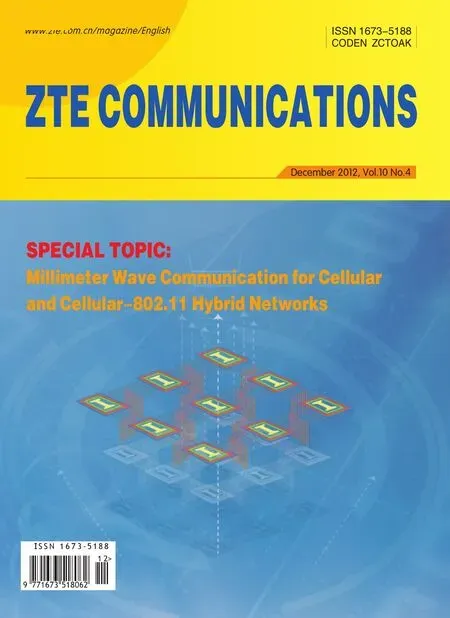Terabit Superchannel Transmission:ANyquist-WDM Approach
Hung-Chang Chien ,Jianjun Yu ,Zhensheng Jia ,and Ze Dong
(1.Optics Lab,ZTE USA Inc.,Morristown,NJ 07960,USA;
2.ZTE Corporation,Shenzhen 518057,P.R.China)
Abstract In this work,we focus on enhancing the network reach in terabit superchannel transmission by using a noise-suppressed Nyquist wavelength division multiplexing(NS-N-WDM)technique for polarization multiplexing quadrature phase-shift keying(PM-QPSK)subchannels at different symbol-rate-to-subchannel-spacing ratios up to 1.28.For the first time,we experimentally compare the transmission reach of this emerging technique with that of no-guard-interval coherent optical orthogonal frequency-division multiplexing(NGI-CO-OFDM)on the same testbed.At BERof 2×10-3 and 100 Gbit/s per channel,an NGI-CO-OFDM terabit superchannel can transmit over a maximum of 3200 km SMF-28 with EDFA-only amplification,and an NS-N-WDM terabit superchannel can transmit over a maximum of 2800 km SMF-28 with EDFA-only amplification.Assuming different coding gain,11×112 Gbit/s per channel with hard-decision(HD)forward-error correction(FEC)and 11×128 Gbit/s per channel NS-N-WDM transmission with soft-decision(SD)FEC can be achieved over a maximum of 2100 km and 2170 km,respectively.These are almost equal and were achieved using digital noise filtering and one-bit maximum likelihood sequence estimation(MLSE)at the receiver DSP.Characteristics including the back-to-back(BTB)curves,the ADC bandwidth requirement,and the tolerance to unequal subchannel power of an NS-N-WDM superchannel were also evaluated.
Keyw ordsoptical OFDM;Nyquist WDM;MLSE This study is supported by National High Technology Research and Development Program of China(No.2012AA011303).
1 Introduction
R apid growth in the amount of global IPtraffic has been caused by the emergence of bandwidth-demanding network services.This has accelerated the commercialization of coherent 100G transport technology based on the widely recognized polarization multiplexing quadrature phase-shift keying(PM-QPSK)modulation format[1].Technology for transmitting beyond 100G is being studied intensively and is based on increasing the symbol rate[2],increasing the number of subcarriers[3],or increasing the modulation levels[4],[5].The predominant multicarrier multiplexing and transmission proposals for next-generation terabit optical transport are no-guard-interval coherent optical orthogonal frequency-division multiplexing(NGI-CO-OFDM)[6]-[8]and Nyquist wavelength-division multiplexing(N-WDM)[9],[10].The former theoretically allows adjacent orthogonal wavelength channels to partly overlap without any crosstalk penalty,and the latter relies on pulse shaping and spectral filtering to optimize the trade-off between interchannel interference(ICI)and intersymbol interference(ISI).In principle,both techniques have the same sensitivity and spectral efficiency;however,in implementation,there are severalphysical limitations that cause suboptimal performance.NGI-CO-OFDM requires analog-to-digital converters(ADC)with large bandwidth and high sampling rate at the receiver.We previously demonstrated NGI-CO-OFDM PM-QPSK superchannel transmission over 3200 km SMF-28 with an oversampling rate of 3.2 GSa/s[11].Ideal N-WDM transmission requires digital-to-analog converters(DAC)with a high sampling rate of 55-65 GSa/s for raised-cosine(RC)pulse shaping of PM-QPSKsignals at 112 Gbit/s and beyond.Unfortunately,this is not widely available yet.Today,most transmission is considered quasi N-WDM;an optical RC pulse can only be loosely approximated using regular fourth-order super-Gaussion or spectrally engineered narrowband filtering,and ISIand ICIpenalties are induced.In[12]and[13],a noise-suppressed N-WDM(NS-N-WDM)demodulation technique was proposed.The technique involves digital noise filtering followed by short-memory maximum likelihood sequence estimation(MLSE).It pinpoints the imperfection of the linear equalizer in the presence of a strongly filtered N-WDM subchannel and significantly increases tolerance towards noise and crosstalk.
In this paper,we describe a series of experiments on NS-N-WDM terabit superchannel transmission and compare the results with those obtained in a previously reported NGI-CO-OFDM experiment[11].The system parameters in all experiments include PM-QPSK modulation format,25 Gbaud symbol rate,25 GHz subchannel spacing,and identical frequency-locked multicarrier light source[11].We found that NS-N-WDM at 100 Gbit/s was capable of 2800 km SMF-28 transmission with BERbelow 2×10-3and 3200 km SMF-28 transmission with BERbelow 4.9×10-3.NGI-CO-OFDM was capable of 3200 km SMF-28 transmission with BERof 2×10-3,which is slightly better performance.For the first time,we experimentally measured and studied a 25 GHz spaced NS-N-WDM superchannel at 128 Gbit/s per channel and found that even though SD-FEC with higher coding gain was assumed,the maximum achievable transmission distance was similar to that of 112 Gbit/s per channel where HD-FEC was assumed.Transmission distance of 2100 km was achieved with 112 Gbit/s per channel and pre-FECBERlimit of 3.8×10-3,and 2180 km was achieved with 128 Gbit/s per channel and pre-FECBERof 2×10-2.
Section 2 details the setups for NS-N-WDM and NGI-CO-OFDM signal generation and transmission experiments.Both setups are based on PM-QPSKat 100 Gbit/s per channel,and Fig.1 shows the breakdown of and main differences between the digital signal processing(DSP)algorithms used in both setups.Section 3 focuses on NS-N-WDM transmission at symbol-rate-to-subchannel-spacing ratios of 1.12 and 1.28,which in principle cannot be realized in NGI-CO-OFDM transmission.We experimentally evaluated and studied symbol rate dependence,achievable distance,optimal launch power,and required ADC bandwidth for NS-N-WDM terabit superchannels.
2 Testbed Setups for NS-N-WDM and NGI-CO-OFDM Transmission
Fig.1 shows the testbed setups for the NS-N-WDM transmission experiment and previous NGI-CO-OFDM transmission experiments for a clear comparison.Both setups have multicarrier light source,individual PM-QPSK modulation for even channels(CHeven)and odd channels(CHodd),400 km EDFA-only recirculating loop,and integrated optical front-end at the coherent receiver.However,NS-N-WDM requires optical spectral shaping to be done along with CHevenand CHoddcombining at the transmitter whereas NGI-CO-OFDM does not.Also,the requirements on ADC bandwidth and sampling rate for NGI-CO-OFDM transmission are much higher than that for NS-N-WDM transmission.Finally,to suppress linear crosstalk in the aggregated superchannel,the receiver DSP for NGI-CO-OFDM uses digital T/2 delay-and-add filtering(DAF)for carrier separation(T is the symbol duration).In NS-N-WDM,linear crosstalk was suppressed by digital postfiltering(T-DAF)followed by MLSEwith a short memory length of 1 bit.The CWlight from an external cavity laser(ECL)with a linewidth less than 100 kHz and output power of 14.5 d Bm was modulated by a cascaded phase modulator(PM)and intensity modulator(IM).PM1was driven by an RFclock at 25 GHz with a peak-to-peak voltage of 17 V,a half-wave voltage loss of 4 V,and insertion loss of 3.8 d B.When studying NGI-CO-OFDM multiterabit transmission,an additional phase modulator PM2was previously used to generate more subcarriers,and this phase modulator was also driven by a high-level RFsignal with synchronized 25 GHz clock[11].After phase modulation,multiple coherent carriers spaced at 25 GHz were generated.Then,a rear IM driven by a synchronized RFclock at 25 GHz was connected to PM2.This IM flattens the generated optical subcarriers to less than 2 d B.After that,the subcarriers were boosted by a polarization-maintaining Erbium-doped fiber amplifier(PM-EDFA)and then underwent Choddand Chevenseparation by a 25/50 GHz optical interleaver(IL).The channel modulation involves an in-phase/quadrature(I/Q)modulator(MOD),a polarization controller(PC),polarization multiplexers(P-MUX),and optical combiner(OC).Each I/Q MOD was driven by two sets of 25 Gbit/s pseudorandom bit sequences(PRBSs)with word lengths of 211-1,which contained two parallel Mach-Zehnder modulators,both biased at the null point and driven at full swing for zero-chirp phase modulation.For NGI-CO-OFDM,Choddand Chevenwere combined by a polarization-maintaining optical coupler(PM-OC),and then the aggregated channelwas polarization-multiplexed by P-MUXOat a time.For NS-N-WDM signal generation,Choddand Chevenwere first individually polarization-multiplexed by P-MUXNand then combined using a wavelength-selective switch(WSS)programmed to operate at 25 GHz interleaving mode for spectral shaping of all input PM-QPSK subchannels.P-MUXO/P-MUXNwas used only for the NGI-CO-OFDM/NS-N-WDM experiment.An optical time delay(TD)was also used along with the optical path of even channels for symbol synchronization between Choddand Cheventributaries.Such symbolsynchronization is not necessarily required for NS-N-WDM.The loop consists of five spans of 80 km SMF-28(with an average span loss of 16.3 d B and chromatic dispersion of 17 ps/km/nm),loop switches(SWs),optical coupler(OC),and EDFA-only amplification without optical dispersion compensation.For each span,dual-stage C-band EDFAs with mid-stage adjustable tilted filters were used to provide a flat gain.Another WSSplaced in the loop was programmed to be a 9 nm wideband optical bandpass filter and was intended to block the accumulated noise peak occurring in the 1530 to 1540 nm region.At the receiver,a tunable bandpass filter(BPF)with 3 d B bandwidth of 0.4 nm was used to select the measured subchannel.The optical front-end comprises an ECL with linewidth less than 100 kHz,which was used as the fiber laser local oscillator(LO),and a polarization-diverse 90-degree opticalhybrid(opt.hyb.),which was used to realize polarization and phase-diverse coherent detection of the LO and received optical signal before balanced photon detection(PD).For NGI-CO-OFDM,the ADC was operated at 80 GSa/s with a 30 GHz analog bandwidth.For NS-N-WDM,this was reduced to 50 GSa/s with a low 13 GHz bandwidth.The DSPof the NGI-CO-OFDM channel involves first extracting the clock by using“square and filter”method and then resampling the signal at twice the symbol rate based on the recovered clock.Second,a T/2-spaced time-domain finite impulse response(FIR)filter was used for electronic dispersion compensation(EDC).Third,subcarriers were separated using T/2 DAF.Finally,classic constant modulus algorithm(CMA)and 21-tap,T/2-spaced adaptive FIRfilters were used for polarization recovery.Carrier recovery was also performed.This included frequency offset estimation by fast Fourier transform and carrier phase recovery by fourth-power Viterbi-Viterbialgorithm.Enhanced DSPfor NS-N-WDM demodulation comprised all the algorithms mentioned except the T/2 DAFalgorithm.T-DAFwas performed after polarization and carrier recovery to suppress undesirable noise and increased linear crosstalk caused by linear equalizers in the presence of aggressive channel filtering.Such T-DAFalso makes possible the use of MLSEwith a short memory length of 1 bit[12],[13].
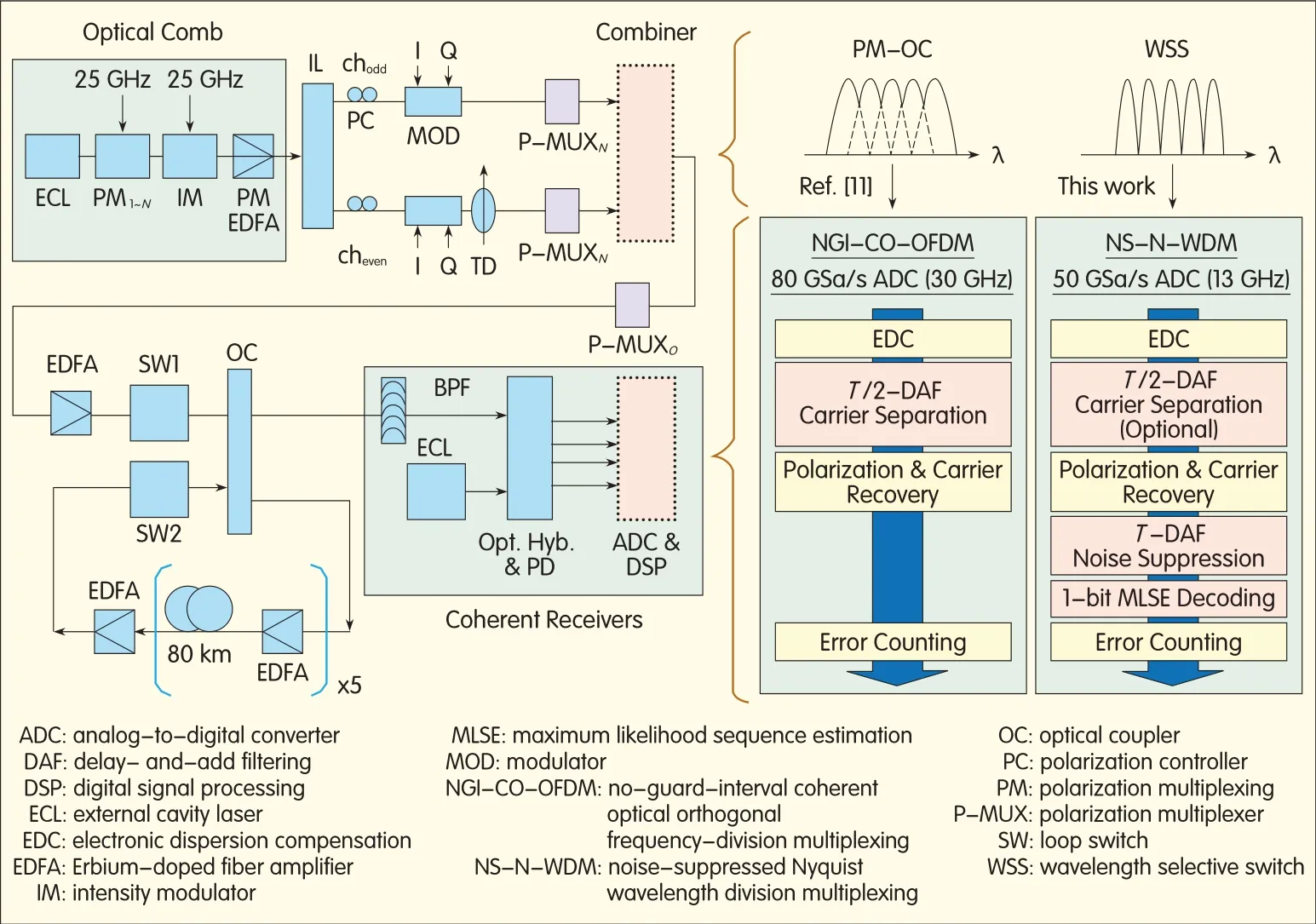
▲Figure 1.Testbed setup and algorithms for NGI-CO-OFDMand NS-N-WDMtransmission experiments.
3 Results and Discussion
3.1 NS-N-WDM versus NGI-CO-OFDM Transmission
Fig.2 shows back-to-back(BTB)BERperformance of NS-N-WDM,NGI-CO-OFDM,and N-WDM.For typical quasiN-WDM,(which has the same transmitter setup as the NS-N-WDM case but without T-DAFand MLSEat the receiver DSP),we obtained a large required OSNRof 17.9 d B at BERof 3.8×10-3.This can be significantly reduced to 15.6 d B by NS-N-WDM demodulation.In addition,NS-N-WDM(11 subchannels)had 0.8 d B less required OSNRthan NGI-CO-OFDM(21 subchannels)at 3.8×10-3BER.Fig.3 shows BERperformance as a function of transmission distance for the NS-N-WDM experiment.The received BERand delivered OSNRat 2800 km is 2×10-3and 16.3 d B,respectively.The received BERand delivered OSNR at 3200 km is 4.9×10-3and 14.8 d B,respectively.The insets in Fig.3 show constellation measured at 2000 km and 2800 km and show how the received QPSK signal was shaped into a 9QAM-like signal after T-DAF.Fig.4 shows BERversus launch power per channelover 2800 km transmission.For BERof less than 3.8×10-3,an input dynamic range of around 4.3 d B was achieved where an optimized operation point was found to be 2 d Bm.Fig.4(upper left inset)shows the received 9QAM-like constellations at-2 d Bm,and Fig.4(upper right inset)shows the received 9QAM-like constellations at 1 d Bm launch power.The lower inset shows equal BERperformance for five even NS-N-WDM subchannels at 2 d Bm launch power.
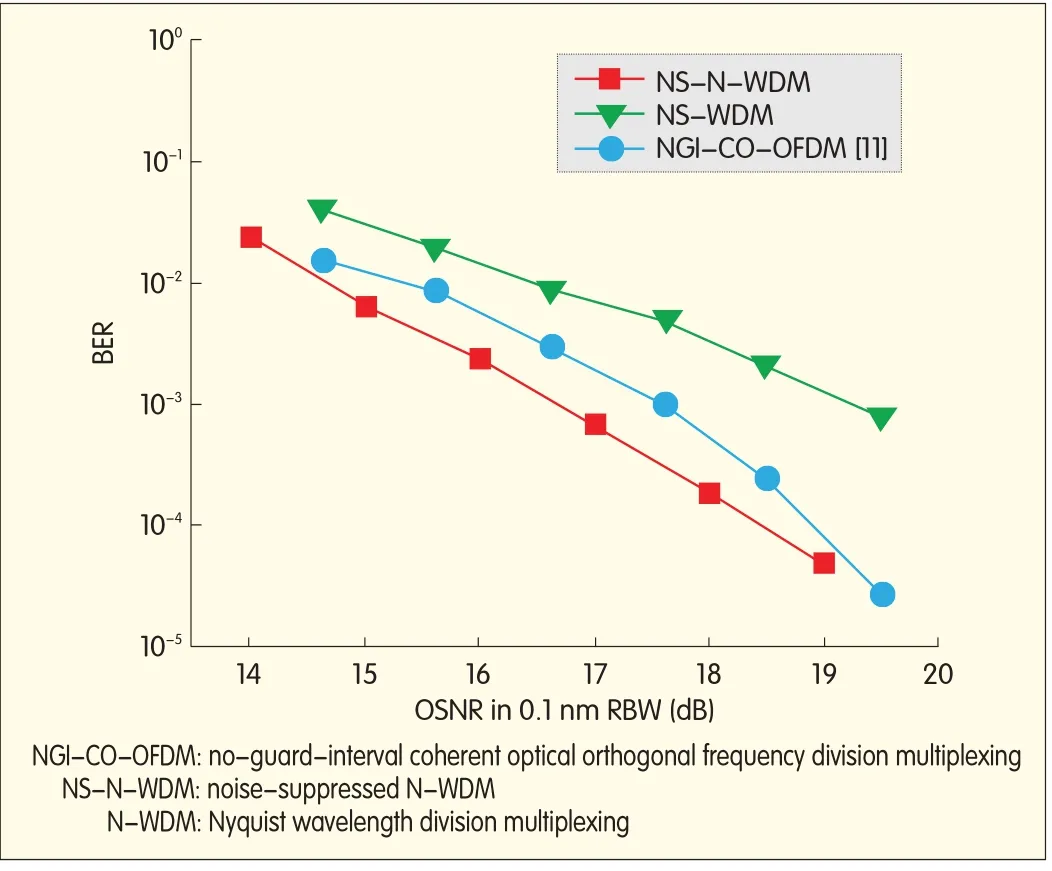
▲Figure 2.BTBBERcurves of NS-N-WDM,N-WDM,and NGI-CO-OFDMwith 25 GHz-spaced 100 Gbit/s PM-QPSK subchannels.
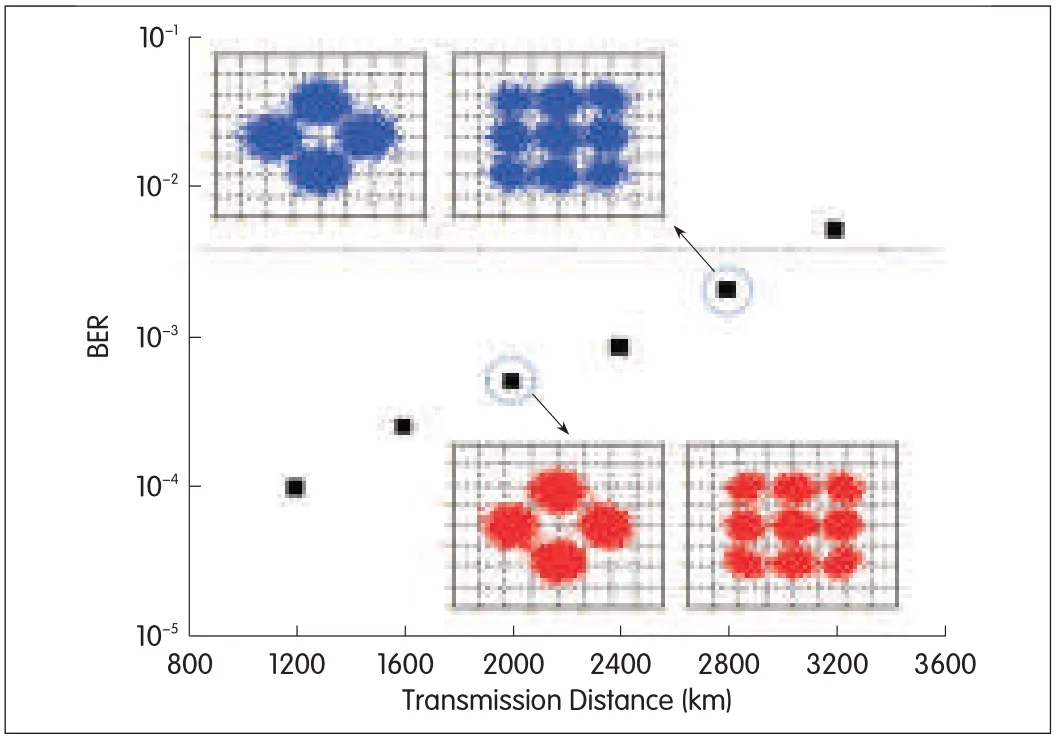
▲Figure 3.Transmission capability of 11×100 Gbit/s NS-N-WDM superchannel.

▲Figure 4.BERperformance as a function of launch power per NS-N-WDMsubchannelover 2800 km SMF-28.
3.2 25 GHz-Spaced NS-N-WDM Transmission at 112 Gbit/s per Channel
A 1TNS-N-WDM superchannel at 100 Gbit/s(25 GSa/s)per subchannel can be transmitted over 2800 km with a BER well below the pre-FEC limit.It is therefore interesting to determine the capability of the NS-N-WDM receiver in the presence of a PM-QPSK subchannel at the true OTU-4 rate of 112 Gbit/s(28 GSa/s)on a 25 GHz grid.Rather than using an optical comb as the light source,we use 11 independent ECLs.The PRBSrate was increased to 28 GSa/s without symbol alignment between Choddand Cheven,and the rest of the setup was unchanged.Fig.5 shows BTB BERperformance for N-WDM using different demodulation schemes with and without adjacent subchannels.If adjacent subchannels are turned off when BER=3.8×10-3,the single PM-QPSK subchannelat 112 Gbit/s had a minimal OSNRof 14.4 d Bwith regular DSP.The typical N-WDM had a large 12.6 d B OSNR penalty mainly because of linear crosstalk.Although this penalty may be reduced by 3 d Bby introducing three-bit maximum a-posteriori(MAP)estimation at the receiver,the required 24 d B OSNRwas still too high for long-haul transmission.However,by using the NS-N-WDM receiver technique with T-DAFand 1 bit MLSE,the OSNRpenalty drops significantly to 1.8 d B(16.2 d B required OSNR).Unlike with the prior NS-N-WDM subchannel at 25 GSa/s,increasing the symbol rate to 28 GSa/s only gives 0.6 d B OSNRpenalty.Fig.6 shows BERas a function of transmission distance when WSSin the loop functions as an ASEfilter and a 25 GHz interleaver.After 2000 km transmission with WSS ASEfiltering,BERof 3.8×10-3can be achieved with received OSNRof 17.6 d B.However,when WSSoperates in interleaving mode as a result of cascaded filtering in the transmission path,only 1200 km is achievable.This means that the bandwidth-narrowing effect of a series of optical filters is significant,and the 11×112 Gbit/s NS-N-WDM superchannel can pass through three 25 GHz in-line optical add-drop filters at most.Fig.6(left inset)shows the optical spectra at 1600 km when the WSSperforms ASEfiltering,and Fig.6(right inset)shows the opticalspectra at 1600 km when the WSSperforms interleaving.
Next,we investigated the required ADC bandwidth for a single 112 Gbit/s NS-N-WDM subchannel by measuring BTB at OSNRaround 17 d B.Fig.7 shows that for BERbelow 3.8×10-3,the ADC digital bandwidth ranges from 16 GHz down to 11 GHz.This has important cost implications for future hardware implementation and production.The inset shows the received RFspectra at 10 GHz,13 GHz,and 20 GHz digitalbandwidth prior to DSP.We further studied the affect of unequalpower between adjacent 112 Gbit/s NS-N-WDM subchannels on BTB system performance at an OSNRof around 18 d B.For simplicity,we chose only upper,central,and lower subchannels and then varied the power increment of the upper and lower subchannels with respect to the centralsubchannel.Fig.8 showsΔPUandΔPL,and Fig.8(inset)shows that the penalty is negligible whenΔPUandΔPLare below 1 d B.
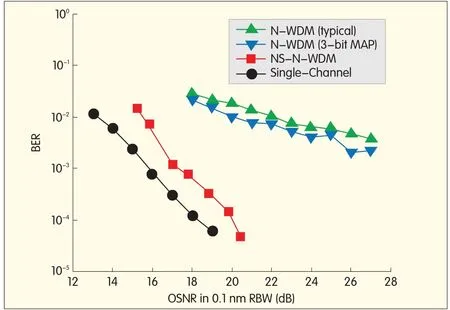
▲Figure 5.BTBBERperformance of N-WDMwith different demodulation schemes at 112 Gbit/s per subchannel.
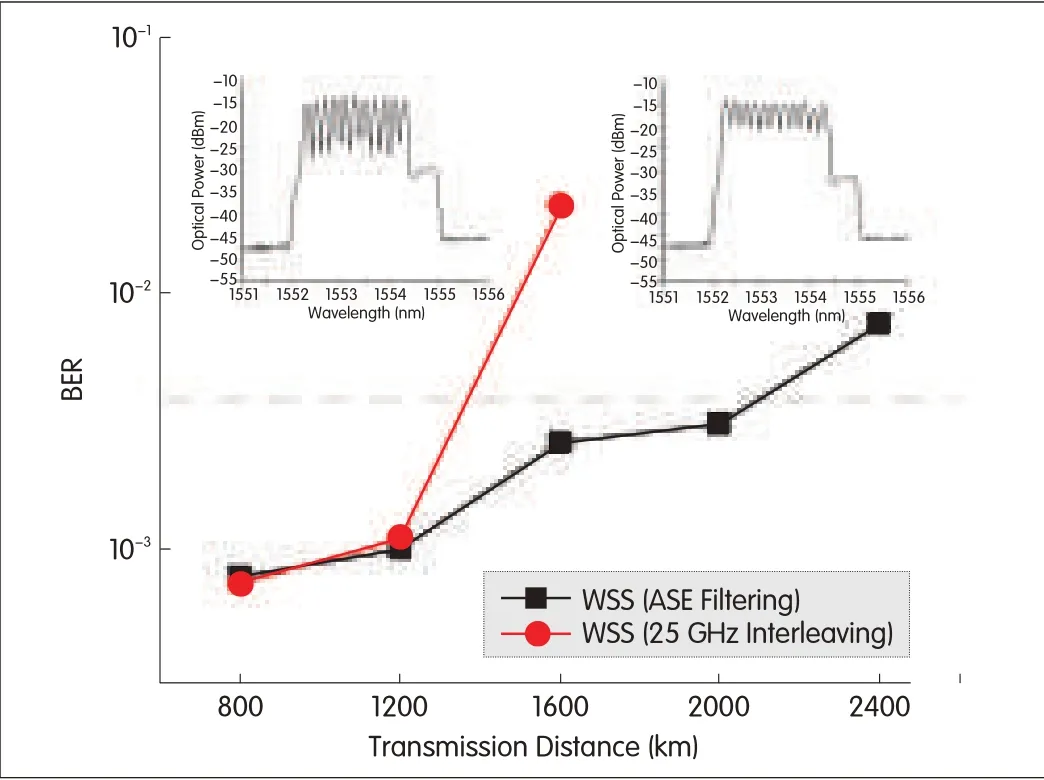
▲Figure 6.Achievable transmission distance of 11×112 Gbit/s NS-N-WDMsuperchannelwith different WSSsettings in the loop.

▲Figure 7.BERperformance as a function of ADCbandwidth.
3.3 25 GHz-Spaced NS-N-WDM Transmission at 128 Gbit/s per Channel
Most new-generation coherent 100G PM-QPSK products come equipped with higher-coding-gain SD-FEC that allows a pre-FEC BERlimit of only 2×10-2.It is instructive to know whether such benefit applies to terabit superchannel transmission.Fig.9 shows BTB NS-N-WDM BERcurves with and without adjacent subchannels at 128 Gbit/s.Results at 112 Gbit/s(Fig.5)are also included for comparison.At 2×10-2BER,the required OSNRis 14.9 d B for a single channel and 15.8 d B for WDM.Then,we put the 11×128 Gbit/s NS-N-WDM superchannel over the loop.Fig.10 shows that below the SD pre-FEC limit,NS-N-WDM signals can potentially be delivered over 2170 km SMF-28.By comparison,even with SD-FEC,typical N-WDM signals can barely reach 1600 km.Fig.10(inset)shows the received constellation diagrams after 2000 km SMF-28 with and without NS-N-WDM demodulation.In light of the results shown in Fig.6,we found that 11×112 Gbit/s per channel NS-N-WDM superchannel with HD and a 11×128 Gbit/s per channel NS-N-WDM superchannel with SD-FEC are both capable of around 2100 km transmission.This may be because in the 32 Gbaud NS-N-WDM case,higher coding gain can only reduce the required OSNRby 0.4 d B.In the 28 GBaud BTB measurement shown in Fig.9,insufficient in-band signal bandwidth was found to be a major constraint.
4 Conclusion

▲Figure 9.BTBBERof NS-N-WDMsuperchannel at112 Gbit/s perchannel and 128 Gbit/s per channel.
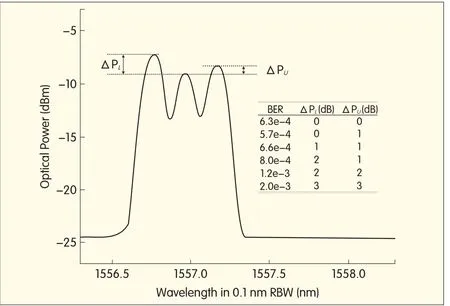
▲Figure 8.Opticalspectrum showing the unequalsubchannelpowerand its impact on the centralsubchannelof interest.
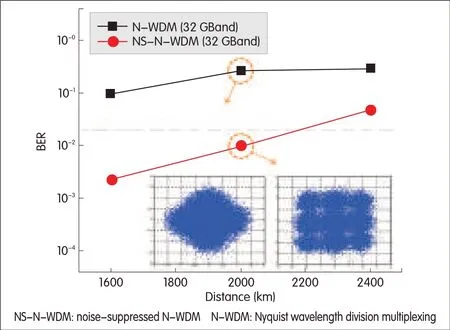
▲Figure 10.Transmission capability of 11×128 Gbit/s Nyquist-WDM superchannels.
We experimented on the transmission capability and characteristics of NS-N-WDM terabit superchannels comprising PM-QPSK subchannels operated at 100,112,128 Gbit/s per channel.All of these superchannels are on 25 GHz ITU-Tgrids.We compared the results with previously reported results by using no-guard-interval NGI-CO-OFDM on the same testbed.NS-N-WDM at 100 Gbit/s per channel was capable of 2800 km SMF-28 transmission with EDFA-only amplification.Although NGI-CO-OFDM exhibited a slightly better reach of 3200 km,its stringent requirement for high ADC bandwidth and sampling rate,precise symbol alignment and synchronization,and co-polarization between subchannels requires more engineering for implementation.In addition,the transmission distances for 112 Gbit/s per channel and 128 Gbit/s per channel NS-N-WDM superchannels were found to be similar,that is,2100 km and 2170 km at pre-FEC BERlimits of 3.8×10-3and 2×10-2,respectively.This implies that acquiring coding gain has no immediate benefit in Nyquist-WDM superchannel transmission if the in-band signalbandwidth is insufficient.In addition,larger,non-standardized grids can be used to reduce crosstalk in N-WDM transmission without DSP enhancement.However,the scope of this work is to explore the limits of terabit N-WDM transmission on the standardized 25 GHz ITU-Tgrid and bring about superior,constant net spectral efficiency for all 100G subchannels at different symbol rates.Although there is an increased penalty at higher symbolrate as a result of deteriorating noise and crosstalk,but this can be mitigated by using digitalnoise filtering and 1 bit maximum likelihood sequence estimation(MLSE)alongside typical receiver DSP.This has been demonstrated here for terabit superchannel transmission over 2000 km SMF-28.
- ZTE Communications的其它文章
- 2013 IET International Conference on Information and Communications Technologies
- ZTELaunches the First PC-Based CPTfor LTENetworks
- ZTECommunications Guidelines for Authors
- ZTELaunches Innovative Energy-Saving Solution for LTENetworks
- Design and Implementation of ZTE Object Storage System
- Hierarchical Template Matching for Robust Visual Tracking with Severe Occlusions

